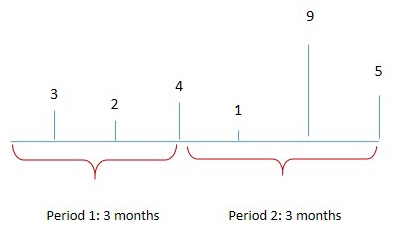Cross period lead time
In multi-period modeling, lead time demand variance should be estimated carefully for the cases where lead times are longer than a period. That is, the lead time demand variabilities within any period that the lead time crosses through should be taken into account. In the case where the lead times are shorter than any given period, Supply Chain Guru X solves an independent safety stock optimization model for each period. However, cases where lead times cross a period makes optimization procedure-dependent.
In Supply Chain Guru X, cross period lead times can be incorporated depending on your preference. You can use a specific parameter, SupportCrossPeriod, to make use of the cross product lead times as described in the following example. Use the Create Advanced IO Parameter Table transformation to create the Config_IO table. For the SupportCrossPeriod parameter, set the ParameterValue to 1 and Status to "Include". When this record is included, Safety Stock Optimization uses the cross period lead time.
We use the following formula to calculate the variance (V) of demand that has different variance values in a two-period model.
where V1 and V2 are the variance in Period 1 and Period 2, respectively. n1 and n2 are the period length of Period 1 and Period 2, respectively. and
are the demand mean across two periods, demand mean in Period 1 and demand mean in Period 2, respectively.
In the following example, we explain how we derive this equation.
Example 1:
Suppose that we are given a two-period model that has a lead time of 6 months. Each period is 3 months long. The demand series is given as follows.

Period 1:
mean = (3+2+4)/3 = 3
variance = ((3-3)^2+(2-3)^2+(4-3)^2))/(3-1) = 1
Period 2:
mean = (1+9+5)/3 = 5
variance = ((1-5)^2+(9-5)^2+(5-5)^2))/(3-1) = 16
Notice that demand mean and variance metrics cannot be added in this case. Therefore, mean and variance over Period 1 + Period 2:
mean = (3+2+4+ 1+9+5)/6 = 4
variance = ((3-4)^2+(2-4)^2+(4-4)^2+(1-4)^2+(9-4)^2+(5-4)^2))/(6-1) = 8
The mean over two periods is calculated by:
Variance in each period is calculated by:
Then:
After some elaboration, we have:
Example 2:
Consider the following cases where we solve a single echelon safety stock optimization problem.

Case 1: Suppose that the fixed order time in MFG (lead time) is given as 15 days for each period. We also assume that the desired service level is 95% using Type1. We use 1.6446758733396285 for the safety factor (z) for 95% target service level.
| Period 1 (30 days) | Period 2 (30 days) | |
| Mean | 100 | 100 |
| Standard Deviation | 50 | 100 |
| Safety Stock | 319 | 637 |
Notice that fixed order time (lead time) is shorter than each period lengths. Safety stock in MFG in each period is calculated as follows.
Safety stock in Period 1:
Safety stock in Period 2:
Case 2: Cross period lead time option is checked. Suppose that the fixed order time in MFG (lead time) is given as 60 days for each period. We also assume that the desired service level is 95% using Type1.
| Period 1 (30 days) | Period 2 (30 days) | |
| Mean | 100 | 100 |
| Standard Deviation | 50 | 100 |
| Safety Stock | 999 | 1274 |
Notice that fixed order time (lead time) is longer than each period lengths. Safety stock in MFG in each period is calculated as follows.
Standard deviation of demand for Period 1 :
Safety stock for Period 1:
Standard deviation of demand for Period 2 : 100
Notice that we assume the same variability for the exceeding period.
Safety stock for Period 2:
Case 3: Cross period lead time option is unchecked. Suppose that the fixed order time in MFG (lead time) is given as 60 days for each period. Assume that the desired service level is 95% using Type1.
| Period 1 (30 days) | Period 2 (30 days) | |
| Mean | 100 | 100 |
| Standard Deviation | 50 | 100 |
| Safety Stock | 637 | 1274 |
Notice that fixed order time (lead time) is longer than each period lengths. However, the user does not want to take into account the cross period lead time effect. Safety stock in MFG in each period is calculated as follows.
Safety stock in Period 1:
Safety stock in Period 2:
Notice that total safety stock in Period 1 is lower if cross period lead time effect is not taken into account.
Last modified: Wednesday May 15, 2024
